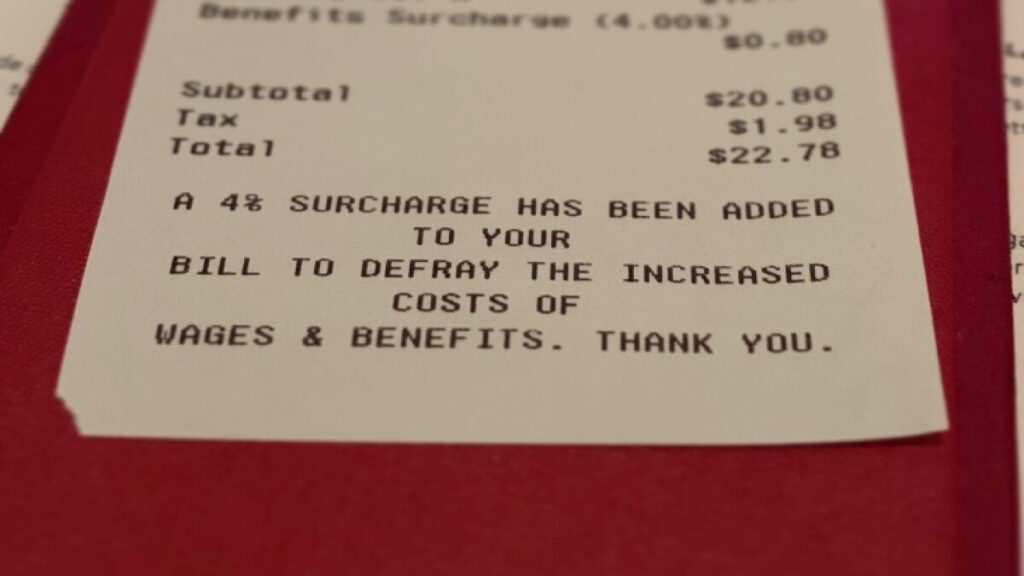
Dining out is a beloved experience, offering a chance to savor delicious food and enjoy a break from home cooking. However, an increasingly common addition to restaurant bills has sparked debate: surcharges. These extra fees, often added to the total bill, can leave diners feeling frustrated and confused. This article aims to shed light on restaurant surcharges, exploring their reasons, diner rights, legal implications, and potential alternatives. We’ll equip you with the knowledge to navigate this complex topic confidently.
Restaurant Surcharges Explained
A surcharge is a supplementary charge added to a customer’s bill, beyond the standard menu prices. These fees can be imposed for various reasons, ranging from staffing shortages to increased ingredient costs. Surcharges are typically presented as a percentage of the total bill or a fixed amount per person. While some restaurants clearly disclose surcharges on their menus, others may only reveal them at the time of payment, leading to potential surprises for unsuspecting diners.
It’s important to note that surcharges differ from service charges, which are mandatory fees added to cover the cost of service staff. Service charges are often included in the bill as a percentage and are typically non-negotiable. Surcharges, on the other hand, are often optional and may be subject to negotiation depending on the circumstances.
Reasons for Surcharges

Restaurants implement surcharges for a variety of reasons, often driven by external factors beyond their control. Some common reasons include:
Increased Operating Costs
Rising costs of ingredients, utilities, and labor can significantly impact a restaurant’s profitability. Surcharges can help offset these expenses, ensuring the restaurant can maintain its quality standards and remain financially viable.
Staffing Shortages
The hospitality industry is facing a global labor shortage, making it challenging for restaurants to find and retain qualified staff. Surcharges can help compensate for the increased cost of hiring and retaining employees.
Peak Season Demand
During peak seasons or special events, restaurants may experience a surge in demand, leading to increased pressure on their resources. Surcharges can help manage this demand and ensure efficient service during busy periods.
Special Events or Promotions
Some restaurants may implement surcharges for special events, such as holiday dinners or themed nights. These surcharges can help cover the additional costs associated with these events, such as special decorations, entertainment, or unique menu items.
Diner Rights Regarding Surcharges
While restaurants have the right to implement surcharges, diners also have certain rights to understand and address these fees.
Transparency and Disclosure
Restaurants are ethically obligated to clearly disclose any surcharges on their menus or at the time of ordering. This allows diners to make informed decisions about their dining experience and budget accordingly.
Inquiry and Explanation
Diners have the right to inquire about the reason for a surcharge and request clarification from the restaurant staff. Understanding the rationale behind the surcharge can help diners assess its legitimacy and make a more informed decision.
Polite Expression of Concerns
If a diner feels a surcharge is unreasonable or unjustified, they can politely express their concerns to the restaurant staff. While refusing to pay a surcharge may not always be feasible, open communication can sometimes lead to a mutually agreeable solution.
Alternative Payment Options
In some cases, diners may be able to negotiate alternative payment options, such as splitting the bill or paying a reduced amount for the surcharge. However, it’s important to approach these requests respectfully and understand that the restaurant may not always be able to accommodate them.
Legal Considerations of Surcharges

The legality of surcharges varies depending on local laws and regulations. Some jurisdictions may have specific rules regarding the implementation and disclosure of surcharges.
State and Local Laws
It’s essential for diners to be aware of the specific laws governing surcharges in their area. Some states may prohibit certain types of surcharges, while others may require restaurants to disclose them prominently.
Contractual Agreements
In some cases, restaurants may include clauses in their terms and conditions that allow for surcharges under specific circumstances. Diners should review these agreements carefully before dining to understand their rights and obligations.
Consumer Protection Agencies
If diners believe a restaurant has implemented surcharges unfairly or illegally, they can file a complaint with their local consumer protection agency. These agencies can investigate the matter and take appropriate action if necessary.
Alternatives to Surcharges
While surcharges can be a necessary tool for restaurants to manage costs, there are alternative strategies they can consider:
Menu Price Adjustments
Restaurants can adjust their menu prices to reflect increased operating costs. This approach provides greater transparency and allows diners to make informed decisions about their spending.
Cost-Saving Measures
Restaurants can explore ways to reduce their operating costs, such as negotiating better deals with suppliers, optimizing inventory management, or implementing energy-saving practices.
Loyalty Programs
Restaurants can offer loyalty programs to reward repeat customers and incentivize them to dine more frequently. This can help generate consistent revenue and offset fluctuations in demand.
Value-Added Services
Restaurants can offer value-added services, such as free Wi-Fi or complimentary appetizers, to enhance the dining experience and attract customers.
Conclusion
Restaurant surcharges have become a common practice, but they can be a source of confusion and frustration for diners. Understanding the reasons behind surcharges, diner rights, legal considerations, and alternative strategies can empower diners to make informed decisions and navigate this complex issue with confidence. Open communication between restaurants and diners is crucial to ensure a fair and transparent dining experience for all.
